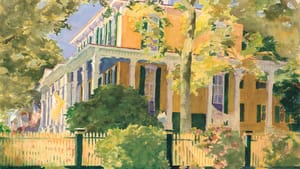Stay in the Loop
BSR publishes on a weekly schedule, with an email newsletter every Wednesday and Thursday morning. There’s no paywall, and subscribing is always free.
Recording the Cape May renaissance
Light Particularly: Alice Steer Wilson’s Cape May

It is a special pleasure to see a place you know well on canvas. Luminous watercolors of Cape May created by Alice Steer Wilson over three decades could have been painted from my memory, as though she’d stood at my shoulder through time. Thirty-six of Wilson’s works are on view through November 1 in Cape May’s Carroll Gallery.
Wilson (1926-2001) arrived just as Cape May, having hit bottom, was poised to rise. She worked outdoors, parking her easel on sidewalks to capture whatever caught her eye, and she might visit favored locations over and over to record different times of day and seasons. Wilson opened eyes to the charm of Victorian trimmings — hairpin fences, wrought iron railings, filigreed eaves, and picture hat roofs, cocked just so to deflect the sun. Her view extended beyond whimsical architecture to the natural world: soft dune grasses, lush gardens, darkening seas, and the unusual light that washes over everything at the tip of New Jersey, transforming color by the instant.
Through commissions, gallery shows, note cards, and spontaneous sales to passersby, Wilson reframed the tiny seashore town, her appreciation dovetailing with a renewed interest in preservation.
Paging through the work in the retrospective compiled by her daughter, on which the exhibition is based, is like viewing a better version of photographs I’ve taken over countless trips beginning in my adolescence. There’s the Pink House, a wedding cake of a building in a bakery of clapboard confections, and the Washington Street Mall, where people still go for the essentials: food, shopping, and benches. Also the long-gone Windsor Hotel, a favorite Wilson subject, and its umbrella-festooned beach, in a scene that could be 1975 or 2015. Wilson recorded secret dune paths and undiscovered streets, falling-down backyard fences and ready-for-company front porches guarded by regiments of spindles. She committed to canvas turreted skylines, the red roof of St. Mary-by-the-Sea, the concrete parapet that is Cape May’s boardwalk, and the lighthouse that watches over it all.
Following her vision
Wilson drew from childhood and studied painting while earning a degree in psychology. In 1966, at 39, the married mother of four enrolled in the Pennsylvania Academy of Fine Arts, where her approach was decidedly out of step with the psychedelic times. Though out of fashion, Wilson never abandoned her representational style, an approach that would well serve the similarly passé shore point.
By the 1970s, Cape May was an anachronism. It was a fussy, faded antique, popular with day-trippers who visited the remains as they might an elderly relative, more out of habit than affection. Block after block of Victorian “cottages” — multistory clapboard houses, warped, sunburned, and peeling, with tightly curled eaves — looked to contemporary eyes like altogether too much trouble; except for architectural historians, who saw luck in the resort’s having been overlooked and, therefore, unimproved. But the land was too potentially valuable to be ignored forever. Cape May was on the knife’s edge.
Enter Wilson. Beginning in 1971, she stayed summers, mastering watercolor, a new medium for her. She followed the light that illuminates Cape May like a prism, shafts bouncing from ocean to bay, sky to sand, dancing over pastel walls and shingled roofs, hurling shadows and transforming colors from pink to white to orange.
Light, particularly
The sun is never hard to find in Cape May — crowd-pleasing sunrises and sunsets are as close as the beach — but Wilson was more interested in what the sun did between those moments. She didn’t want to miss its arc through the sky, enlivening the air with subtle expectation, an unpredictability, the possibility of surprise. I understand. Year after year, the same images turn up in my photographs, yet if I didn’t take them, I’d feel I was missing something. I can’t not shoot.
Wilson and her husband purchased a home in Cape May in 1979, making her privy to sights known only to year-round residents. Summer visitors can only imagine what Cape May looks like crusted in snow, but Wilson painted images of cottages that look like castles made of sugar.
The challenge of capturing particular moments of light kept Wilson painting. Shortly after her death in 2001, a pencil notation was found on the back of a canvas she’d painted in 1974. It was her mission statement: “In case my paintings are ever ‘discovered’ after I’m dead, this is my statement of what I was trying to do. I loved the appearance of things, light particularly, and I tried to copy it as accurately as I could, leaving out what was boring and exaggerating what I liked. Why I loved certain sights better than others I never understood, and neither do the people who are explaining it to you now.”
Wilson’s watercolors need no explanation.
What, When, Where
Light Particularly: Alice Steer Wilson’s Cape May, through November 1 at the Carroll Gallery, Mid-Atlantic Center for the Arts & Humanities, 1048 Washington Street, Cape May, New Jersey. capemaymac.org
Alice Steer Wilson: LIGHT, PARTICULARLY by Janice Wilson Stridick. Southbound Press, 2013. Available at Amazon.
Sign up for our newsletter
All of the week's new articles, all in one place. Sign up for the free weekly BSR newsletters, and don't miss a conversation.